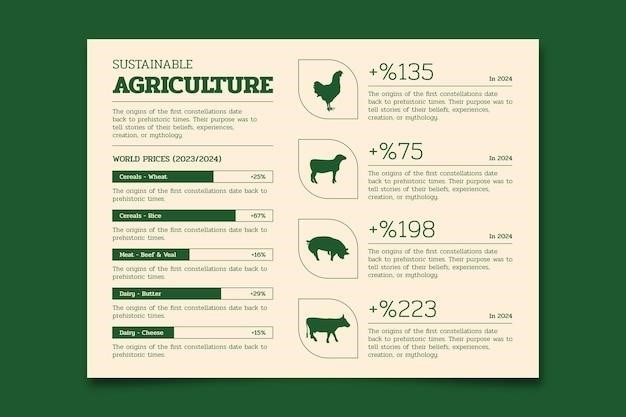
Cattle Vaccination Schedule⁚ A Comprehensive Guide
This guide provides a comprehensive overview of cattle vaccination schedules, covering essential aspects like the importance of vaccination, types of vaccines available, factors influencing vaccination schedules, and specific recommendations for different stages of cattle life.
Introduction
Cattle vaccination is a cornerstone of effective herd health management, playing a crucial role in preventing and controlling infectious diseases that can significantly impact productivity and profitability. A well-structured vaccination program is essential for safeguarding the well-being of your cattle, minimizing disease outbreaks, and ensuring optimal herd performance. This comprehensive guide delves into the intricacies of cattle vaccination schedules, providing valuable insights into the importance of vaccination, the various types of vaccines available, factors influencing vaccination schedules, and specific recommendations for different stages of cattle life.
From pre-calving to post-calving vaccination schedules, as well as schedules for breeding animals, adult dairy cattle, and livestock, this guide offers a detailed roadmap for developing a robust vaccination strategy. It highlights the importance of considering individual herd needs, disease prevalence in the region, and the specific vulnerabilities of your cattle when designing a vaccination program. By understanding the principles behind vaccination and the intricacies of different vaccine types, you can make informed decisions to protect your herd from a wide range of infectious threats.
This guide serves as a valuable resource for cattle producers, veterinarians, and other stakeholders involved in cattle health management. It aims to provide a clear understanding of the fundamental principles of cattle vaccination and equip you with the necessary knowledge to develop and implement effective vaccination programs that contribute to the overall health and productivity of your herd.
Importance of Vaccination in Cattle Health Management
Vaccination stands as a vital pillar in safeguarding cattle health, playing a pivotal role in preventing and controlling infectious diseases that can wreak havoc on herds. Infectious diseases pose a significant threat to beef and dairy cattle, compromising their health, welfare, and ultimately, productivity. Vaccination acts as a crucial tool in mitigating these risks, contributing to improved herd health, reduced mortality rates, and enhanced profitability.
By introducing weakened or inactive forms of disease-causing agents into the body, vaccines stimulate the immune system to develop a robust defense mechanism. This immune response equips the cattle with the ability to recognize and effectively combat the targeted pathogens, preventing severe illness and even death. Vaccination not only protects individual animals but also contributes to herd immunity, reducing the spread of infectious diseases within the population. A well-vaccinated herd is less susceptible to outbreaks, ensuring greater stability and minimizing the economic impact of disease.
Beyond disease prevention, vaccination plays a crucial role in maintaining herd productivity. By reducing illness and mortality, vaccination enables cattle to thrive, maximizing their growth potential and milk production. This translates into increased profitability for cattle producers, as they can enjoy higher yields and reduced veterinary expenses. Vaccination is a cost-effective investment in herd health, ensuring a healthy and productive herd that contributes to a thriving agricultural industry.
Types of Vaccines for Cattle
The world of cattle vaccines encompasses a diverse array of options, each tailored to target specific diseases and provide tailored protection. These vaccines fall into two primary categories⁚ modified live vaccines (MLV) and killed vaccines (inactivated vaccines). Modified live vaccines contain weakened versions of the disease-causing organisms, which are still capable of stimulating an immune response but lack the ability to cause illness. Killed vaccines, on the other hand, contain inactivated or dead versions of the pathogens. While they cannot replicate, they still trigger the immune system to develop antibodies against the targeted disease.
The choice between MLV and killed vaccines depends on various factors, including the specific disease, the age of the cattle, and the desired duration of immunity. MLV vaccines generally provide longer-lasting protection, often lasting for a year or more. They are typically administered once or twice annually, depending on the vaccine and the specific disease targeted. Killed vaccines, while offering shorter-term protection, are often preferred for animals that are pregnant or immunocompromised, as they pose a lower risk of causing illness;
In addition to the primary categories, cattle vaccines can be further classified based on the specific diseases they target. Some vaccines provide protection against a single disease, while others are multivalent, offering protection against multiple diseases in a single dose. For instance, there are vaccines specifically designed to protect against diseases like bovine respiratory syncytial virus (BRSV), bovine viral diarrhea (BVD), and leptospirosis. Multivalent vaccines, such as those targeting clostridial diseases, offer protection against a range of bacterial infections.
Factors Influencing Vaccination Schedules
Developing an effective cattle vaccination schedule is a multifaceted process that requires careful consideration of several key factors. These factors influence the choice of vaccines, the timing of vaccinations, and the overall effectiveness of the program. Understanding these factors is crucial for maximizing the benefits of vaccination and ensuring the health and productivity of the herd.
One of the most important considerations is the specific diseases prevalent in the region and the herd’s exposure risk. The presence of certain diseases in the environment, the movement of cattle, and the proximity to other livestock operations can all influence the likelihood of disease outbreaks. For example, if a region is known to have a high incidence of bovine respiratory disease, vaccination against respiratory pathogens would be a priority.
Another crucial factor is the age and physiological status of the cattle. Calves, being more susceptible to disease, often require a more comprehensive vaccination program with booster doses to ensure adequate immunity. Pregnant cows, on the other hand, may require specific vaccines to protect both the dam and the developing fetus. The reproductive status of the herd, including breeding season and calving dates, also plays a role in determining the optimal vaccination schedule.
The management practices employed on the farm also influence vaccination schedules. The level of biosecurity, the herd’s nutritional status, and the presence of other stressors can all impact the effectiveness of vaccines. For instance, a herd with poor nutrition or high levels of stress may require additional booster doses to ensure adequate immunity.
Pre-Calving Vaccination Schedule
The pre-calving vaccination schedule for cows and heifers is crucial for protecting both the dam and the calf from potential diseases. This period is a time of significant physiological stress for the cow, making them more susceptible to infections. A well-timed vaccination program can help bolster their immune system and minimize the risk of complications.
One of the most important vaccines to administer during this period is the scours vaccine. Scours, also known as diarrhea, is a common and potentially fatal condition in calves, often caused by bacteria such as E. coli. Vaccination against scours typically involves administering a booster dose 3-6 weeks after the initial vaccination, ideally 3 months before the expected calving date. This timing allows for adequate time for the cow to develop protective antibodies that can be transferred to the calf through colostrum.
Other vaccines commonly administered during the pre-calving period include those for respiratory diseases such as bovine respiratory syncytial virus (BRSV), bovine viral diarrhea (BVD), and infectious bovine rhinotracheitis (IBR). These viruses can cause pneumonia, reproductive problems, and even death in cattle. Vaccination against these diseases can significantly reduce the risk of infection and improve the overall health of the herd.
It is essential to consult with a veterinarian to determine the specific pre-calving vaccination schedule that best suits your herd’s needs. Factors such as the herd’s history, the prevalence of diseases in the region, and the management practices employed will all influence the recommended vaccination protocol.
Post-Calving Vaccination Schedule
The post-calving vaccination schedule focuses on protecting both the cow and the newly born calf from a range of diseases. This period is crucial for ensuring the calf receives adequate colostrum, which provides essential passive immunity. The cow’s immune system is also still recovering from the stress of calving, making her more vulnerable to infections.
One of the primary focuses of the post-calving vaccination schedule is to protect the calf from scours. While pre-calving vaccination of the cow helps transfer antibodies to the calf through colostrum, a booster vaccination for the calf at around 4-6 weeks of age can further enhance its immunity. This booster can be administered alongside other essential vaccines, such as those for respiratory diseases like BRSV, BVD, and IBR.
The post-calving period is also an opportune time to vaccinate the cow against diseases like leptospirosis, which can be transmitted through contaminated water and urine. Leptospirosis can cause reproductive problems, abortion, and even death in cattle. Vaccination against this disease helps protect both the cow and the calf.
A veterinarian’s advice is essential for establishing a post-calving vaccination schedule that aligns with your herd’s specific needs. Factors like the age of the calf, the prevalence of diseases in the region, and the overall health of the herd will all influence the recommended vaccination protocol. By carefully considering these factors and following a comprehensive vaccination schedule, producers can significantly enhance the health and productivity of their cattle.
Vaccination Schedule for Breeding Animals
Breeding animals require a specialized vaccination schedule to ensure optimal reproductive health and the production of healthy offspring. A well-designed vaccination program can significantly reduce the risk of infectious diseases that can negatively impact fertility, gestation, and calf survival.
One of the most critical aspects of vaccination for breeding animals is protecting against diseases that can cause abortion or premature birth. Leptospirosis, for instance, is a bacterial disease that can lead to abortion in cattle. Vaccination against leptospirosis is therefore highly recommended for breeding cows and heifers.
Another important consideration is vaccinating against respiratory diseases, as these can weaken the immune system and compromise reproductive performance. Vaccines for IBR (Infectious Bovine Rhinotracheitis), BVD (Bovine Viral Diarrhea), and PI3 (Parainfluenza 3) are commonly included in vaccination programs for breeding animals. These vaccines help protect against respiratory infections that can lead to illness, reduced milk production, and even death.
It’s essential to consult with a veterinarian to determine the most appropriate vaccination schedule for your breeding herd. The veterinarian will consider factors such as the age of the animals, the prevalence of diseases in your region, and the specific needs of your operation. A tailored vaccination program will help ensure the health and productivity of your breeding animals and the successful production of healthy calves.
Recommended Vaccination Schedule for Adult Dairy Cattle
Adult dairy cattle require a comprehensive vaccination program to protect against a range of diseases that can impact their health, productivity, and profitability; A well-designed vaccination schedule helps maintain herd health, minimize disease outbreaks, and optimize milk production.
A key component of the vaccination schedule for adult dairy cattle is the protection against respiratory diseases. IBR (Infectious Bovine Rhinotracheitis), BVD (Bovine Viral Diarrhea), and PI3 (Parainfluenza 3) are common respiratory pathogens that can cause significant losses in dairy herds. Vaccination against these diseases is essential to prevent respiratory infections, reduce the risk of pneumonia, and minimize milk production losses.
Another important consideration is vaccinating against mastitis, a common udder infection in dairy cows. Mastitis can lead to reduced milk production, lower milk quality, and even premature culling of cows. Vaccination against mastitis can help reduce the incidence of this disease and protect the udder health of dairy cows.
It’s essential to work closely with a veterinarian to develop a customized vaccination schedule for your dairy herd; The veterinarian will consider factors such as the age of the cows, the prevalence of diseases in your region, and the specific needs of your operation. A tailored vaccination program will help ensure the health and productivity of your dairy cattle and optimize milk production.
Vaccination Schedule for Livestock
A comprehensive vaccination program is crucial for maintaining the health and productivity of livestock, including cattle, sheep, goats, and pigs. Vaccination plays a vital role in preventing and controlling infectious diseases that can spread rapidly within livestock populations, leading to significant economic losses and animal welfare concerns.
A well-designed vaccination schedule for livestock should consider several factors, including the type of livestock, their age, the prevalence of diseases in the region, and the specific risks associated with the farming operation. It’s essential to work closely with a veterinarian to develop a customized vaccination program that addresses the unique needs of your livestock herd.
Key diseases to consider when developing a livestock vaccination schedule include foot-and-mouth disease (FMD), haemorrhagic septicaemia (HS), black quarter (BQ), and rabies. FMD is a highly contagious viral disease that can cause severe economic losses in livestock industries. Haemorrhagic septicaemia is a bacterial infection that can cause death in cattle, sheep, and goats. Black quarter is a bacterial disease that affects cattle, causing severe muscle damage and death. Rabies is a viral disease that can be transmitted from animals to humans, posing a significant public health risk.

Vaccination against these diseases is essential to protect livestock from infection and minimize the risk of outbreaks. Regular vaccination, along with other biosecurity measures, is crucial for maintaining the health and welfare of livestock and ensuring the sustainability of livestock farming operations.
Implementing a comprehensive cattle vaccination program is essential for protecting herd health, maximizing productivity, and ensuring the financial viability of cattle operations. A well-designed vaccination schedule minimizes the risk of infectious diseases, reduces mortality rates, and promotes overall herd resilience. The specific vaccines and vaccination schedule should be tailored to the individual needs of each herd, considering factors like age, breed, geographical location, and disease prevalence.
It’s crucial to consult with a veterinarian to develop a personalized vaccination program that addresses the unique challenges faced by each cattle operation. Regular monitoring and adjustments to the vaccination schedule may be necessary based on changes in disease patterns, environmental factors, and the overall health status of the herd.
Beyond vaccination, other essential components of effective cattle health management include proper nutrition, stress reduction, adequate ventilation, and effective sanitation practices. By integrating a comprehensive approach to cattle health management, including vaccination, producers can significantly reduce the risk of disease outbreaks and optimize the productivity and profitability of their operations.




